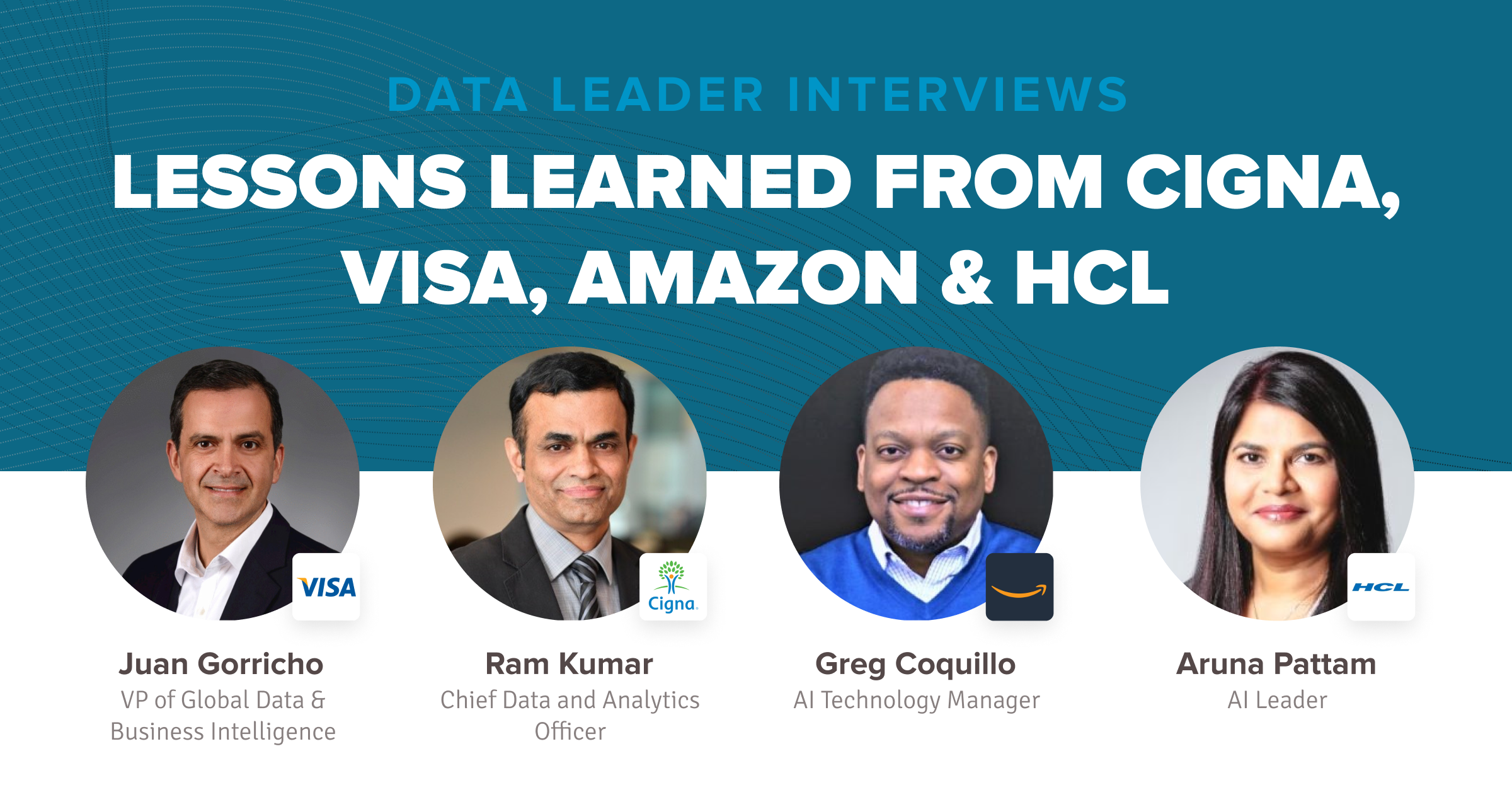
I recently connected with a few of the top data leaders to discuss the role of business analytics and machine learning at their organizations. We chatted about the nuances of global data programs, promoting data literacy at large enterprises, measuring the impact of AI on the business, and many other fascinating topics.
The guest speakers I spoke to included: Ram Kumar, Chief Data and Analytics Officer at Cigna; Juan Gorricho, VP of Global Data & Business Intelligence at Visa; Aruna Pattam, Head of AI and Data Science at HCL; and Greg Coquillo, AI Technology Manager at Amazon.
Here are some of the questions I asked, and the insightful responses from the industry experts.
How do global regions have differing views, attitudes, and habits when it comes to data and analytics?
Ram Kumar explained that every country or region likes to think they’re special, but at a high level, they all have the same problems to address. The difference is in how they solve these problems.
“One size doesn’t fit all is the rule to always keep in mind when you have a global role like his,” said Kumar. He learned this golden rule over the years while overseeing Cigna’s data programs across 30+ countries. There are different stakeholders for each region to deal with, making his task for identifying and prioritizing data analytics use cases an interesting challenge.
At the same time, Kumar believes this also creates a great opportunity to really focus on what matters to the business. “In international markets, each business is unique in terms of products and services, revenue, growth, strategy, business processes, priorities, and more,” he explained. He added that there are also differences within each region’s data and analytics landscape, data capabilities and skills, and maturity in key areas like analytics.
“Everything is unique, so one has to be mindful of these differences when building and executing a strategy,” Kumar said. “There has to be a balance between the overall strategic priorities of the business and the strategic ambitions of each region.”
According to Kumar, Cigna is able to strike the right balance by using a comprehensive data analytics framework. “It’s a framework that the stakeholders are comfortable with,” he explained, “because they know that they’ll get the right strategy for their business.”
How do you promote data literacy?
Being connected with what the business is trying to achieve is essential to promoting data literacy, according to Juan Gorricho of Visa. This connection enables his team to understand the business well enough to bring data to the business; but it also helps business teams understand how to bring business problems to the data.
“In many situations, data teams are used as just a source for the data,” Gorricho said. “But what we’re trying to do differently is understand the problem they’re trying to solve and then show them how to use the data.” The different approach has empowered business teams at Visa to solve more data-related problems on their own.
Gorricho’s team has implemented this collaboration between data and the business through extensive training with Visa business teams. “We’re constantly building training programs about what data assets are available, what they mean, and how they can be used,” he explained. His team also creates custom training programs for specific business teams to solve problems relevant to them.
“Promoting data literacy requires a very strong connection with the business teams,” Gorricho said. “It’s being able to talk about and understand what the business teams do at a high level and being humble enough to ask them to share their knowledge.”
How do you measure the success of AI programs?
Aruna Pattam of HCL says there are multiple factors that impact AI programs, so measuring success is not always straightforward. However, HCL uses an approach called business experiments as a service, which simplifies the AI investment value chain. The focus of these experiments is to show that AI programs generate value that’s ten times more than their cost. Only then will they qualify for wider adoption.
“Even before any real investments are made, we can build an AutoML model and have criteria to measure the successes and outcomes of the experiment,” Pattam said. “This helps keep the entire process honest and ensures the focus is on the business outcome rather than the technical POC.”
How can you promote a data-driven culture?
Greg Coquillo believes that in a data-driven culture, data literacy is a goal for the entire organization and implementing KPIs related to data literacy is part of the company’s overall strategy. For data literacy specifically, these metrics could measure data skills, how much training material is available, and the number of training sessions completed by employees.
“Businesses really need to focus on how to hire, retain, and develop their employees,” Coquillo said. This means providing them with the right materials so that they can constantly improve.”
Ultimately, a data-driven culture requires a proactive approach to encourage employees to develop new data skills and shift their mindset so they’re more comfortable using data to solve business challenges.
You can watch the full discussion I had with these data leaders here. In addition, we put together an eBook with 15 thought leaders and experts in the data industry about scaling AI and BI at large organizations.


SHARE
Guide: How to Choose a Semantic Layer